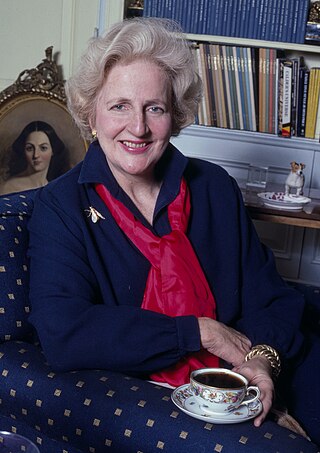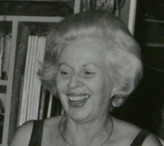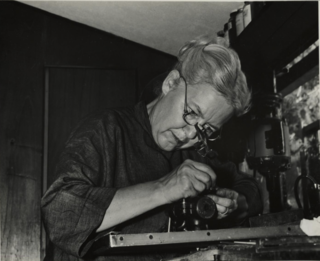Related Research Articles

Art jewelry is one of the names given to jewelry created by studio craftspeople in recent decades. As the name suggests, art jewelry emphasizes creative expression and design, and is characterized by the use of a variety of materials, often commonplace or of low economic value. In this sense, it forms a counterbalance to the use of "precious materials" in conventional or fine jewelry, where the value of the object is tied to the value of the materials from which it is made. Art jewelry is related to studio craft in other media such as glass, wood, plastics and clay; it shares beliefs and values, education and training, circumstances of production, and networks of distribution and publicity with the wider field of studio craft. Art jewelry also has links to fine art and design.

Letitia "Tish" Baldrige was an American etiquette expert, public relations executive and author who was most famous for serving as Jacqueline Kennedy's Social Secretary.
Robert William Ebendorf is an American metalsmith and jeweler, known for craft, art and studio jewelry, often using found objects. In 2003–2004, the Smithsonian American Art Museum organized an exhibition of 95 pieces, titled The Jewelry of Robert Ebendorf: A Retrospective of Forty Years.

Mary Lee Hu is an American artist, goldsmith, and college educator, known for using textile techniques to create intricate woven wire jewelry.

Dorothy Wright Liebes was an American textile designer and weaver renowned for her innovative, custom-designed modern fabrics for architects, interior designers, and fashion designers. She was known as "the mother of modern weaving".

Gijs Bakker is a Dutch jewellery and industrial-designer, educated at the Gerrit Rietveld Academie in Amsterdam, the Netherlands and the Konstfackskolan in Stockholm, Sweden.
Gary Lee Noffke is an American artist and metalsmith. Known for versatility and originality, he is a blacksmith, coppersmith, silversmith, goldsmith, and toolmaker. He has produced gold and silver hollowware, cutlery, jewelry, and forged steelware. Noffke is noted for his technical versatility, his pioneering research into hot forging, the introduction of new alloys, and his ability to both build on and challenge traditional techniques. He has been called the metalsmith's metalsmith, a pacesetter, and a maverick. He is also an educator who has mentored an entire generation of metalsmiths. He has received numerous awards and honors. He has exhibited internationally, and his work is represented in collections around the world.
Bill Smith is an American fashion and jewelry designer who was the first black recipient of a Coty Award for his designs. He has designed for a number of companies, including costume jewelry for Coro and Richelieu, leather goods for Mark Cross, and furs for Ben Kahn, along with designing jewelry for Cartier.
George William Headley III was an American jewelry designer, collector, socialite and founder of the Headley-Whitney Museum in Lexington, Kentucky. As a designer, he was known for collaborations with Salvador Dalí, Paul Flato, David Webb and Cartier, between the 1920s and 1960s, with clients including Douglas Fairbanks, Gary Cooper, the Marx Brothers, Judy Garland and Joan Crawford, as well as for his extravagant bibelots - small, intricate and precious decorative objects.

John Paul Miller was an American jewellery designer and goldsmith, who also produced films, photographs and paintings. Stephen Harrison, decorative arts curator at the Cleveland Museum of Art, compares Miller's work with that of René Lalique and Louis Comfort Tiffany.

Catherine Elizabeth Cooke was an American designer principally known for her jewelry. She has been called "an icon within the tradition of modernist jewelry" and "a seminal figure in American Modernist studio jewelry". Her pieces have been shown nationally and internationally and are included in a number of museum collections, including the Museum of Modern Art (MOMA) in New York. She is regarded as an important role model for other artists and craftspeople.
Janet Payne Bowles was an American art educator, metalsmith, and jewelry designer from Indianapolis, Indiana, who is best known for creating intricate Arts-and-Crafts-style jewelry, flatware, and other small objects. Although the self-taught artisan had little commercial success during her lifetime, she became famous after designing a jewelry collection for actress Maude Adams to wear in a stage production of As You Like It. Sir Caspar Purdon Clarke and J. P. Morgan commissioned Payne Bowles to make severals pieces of metalwork and jewelry for their collections. She also regularly exhibited her art in the United States and Europe and taught art classes at Shortridge High School in Indianapolis from 1912 until her retirement in 1942. Examples of Payne Bowles's work are included in the collections of the Indianapolis Museum of Art. She also wrote book reviews for Modern Art in the early years of her career and contributed articles to The Craftsman in 1904, Handicraft in 1909 and in 1910, and Jewelers' Circular Weekly in 1911. In addition, Payne Bowles provided illumination paintings for limited-edition books such as The Second Epistle of John (1901). Her novel, Gossamer to Steel, was published in 1917.
Jamie Bennett is an American artist and educator known for his enamel jewelry. Over his forty-year career, Bennett has experimented with the centuries-old process of enameling, discovered new techniques of setting, and created new colors of enamel and a matte surfaces. This has led him to be referred to as “one of the most innovative and accomplished enamellers of our time” by Ursula Ilse-Neuman, historian and former curator at the Museum of Art and Design in New York City. Bennett is closely associated with the State University of New York at New Paltz, where he studied himself as a student, and taught in the Metal department for many years. Bennett retired from teaching in 2014, after thirty years at SUNY New Paltz.
Myra Mimlitsch-Gray is an American metalsmith, artist, critic, and educator living and working in Stone Ridge, New York. Mimlitsch-Gray's work has been shown nationally at such venues as the John Michael Kohler Arts Center, Museum of the City of New York, Metropolitan Museum of Art, Cooper-Hewitt Smithsonian Design Museum, and Museum of Arts and Design. Her work has shown internationally at such venues as the Middlesbrough Institute of Modern Art, Stadtisches Museum Gottingen, and the Victoria and Albert Museum, and is held in public and private collections in the U.S, Europe, and Asia.

Alma Rosalie Eikerman was an American metalsmith, silversmith, and jewelry designer who was instrumental in building the metals program at Indiana University, of which she retired Distinguished Professor Emeritus. She was a founding member of the Society of North American Goldsmiths and studied under several internationally renowned metalsmiths, such as Karl Gustav Hansen. Eikerman's work has appeared in over 200 exhibitions, including Objects: USA at the Smithsonian Institution.

Shaun Leane is a British jewellery designer best known for his sculptural pieces created for Alexander McQueen. His eponymous jewellery brand is a four-time winner of the UK Jewellery Designer of the Year award.

Margaret De Patta was an American jewelry designer and educator, active in the mid-century jewelry movement.

Marjorie Schick was an innovative American jewelry artist and academic who taught art for 50 years. Approaching sculptural creations, her avant-garde pieces have been widely collected. Her works form part of the permanent collections of many of the world's leading art museums, including the Hermitage Museum in Saint Petersburg, Russia; the Museum of Arts and Design in New York City; the National Museum of Modern Art in Kyoto, Japan; the Philadelphia Museum of Art in Pennsylvania; and the Victoria and Albert Museum of London.

Merry Renk, also known as Merry Renk-Curtis, was an American jewelry designer, metalsmith, sculptor and painter. In 1951, she helped to found the Metal Arts Guild (MAG), and served as its president in 1954.

Mary Ann Scherr was an American designer, metalsmith and educator. She was known for her jewellery design and industrial design, but she also worked as a graphic designer, illustrator, game designer, fashion and costume designer and silversmith.
References
- 1 2 3 "Clifton Nicholson: A Retrospective". Kentucky Museum of Art and Craft. Archived from the original on September 25, 2016. Retrieved November 30, 2012.
- 1 2 3 4 5 6 7 Pederson Budge, Rose Mary (October 19, 1982). "By nature, his work is varied, fascinating". The Deseret News. Retrieved November 30, 2012.
- 1 2 3 4 5 6 "Clifton Nicholson: A Retrospective: Artistic Influences". Kentucky Museum of Art and Craft. Archived from the original on September 24, 2016. Retrieved November 30, 2012.
- ↑ Baldrige, Letitia (2003). Letitia Baldrige's new manners for new times : a complete guide to etiquette. New York: Scribner. p. 587. ISBN 9780743210621.
- 1 2 "Clifton Nicholson: A Retrospective". Kentucky Museum of Art and Craft. Retrieved November 30, 2012.
- 1 2 "Jewelry Genius Becomes a Veep". Ebony. October 1968. pp. 92–94. Retrieved November 28, 2012.
- ↑ Wessenger, Gerald (2007). A Charmed Life. iUniverse. p. 196. ISBN 9780595451111.
- ↑ McDowell, Colin (1984). McDowell's Directory of Twentieth Century Fashion. Frederick Muller. pp. 299–301. ISBN 0-584-11070-7.
- 1 2 3 "Designers Create Exciting Look for Diamond Jewelry". Ocala Star Banner. March 20, 1974. Retrieved November 30, 2012.
- ↑ Christy, Marian (November 3, 1971). "Jewelry has Occult Theme". The Beaver County Times. Retrieved November 29, 2012.
- ↑ Lambert, Eleanor (September 19, 1970). "Ethnic Theme Monopolises Front Seat in Fashion". The News and Courier. Archived from the original on May 6, 2020. Retrieved November 29, 2012.
- ↑ "Roughwood Aviaries run by Clifton Nicholson". Kentucky Museum of Art and Craft. Retrieved November 30, 2012.